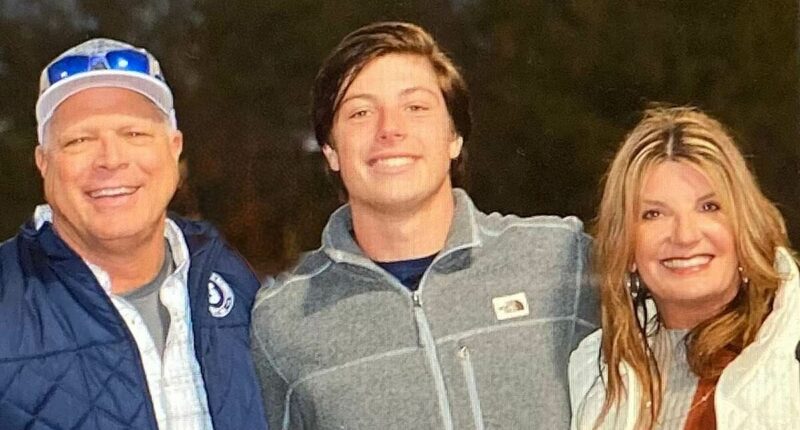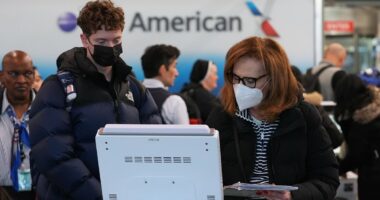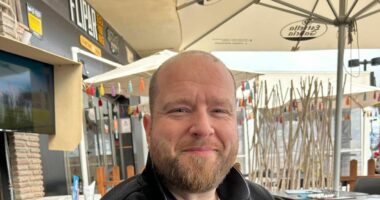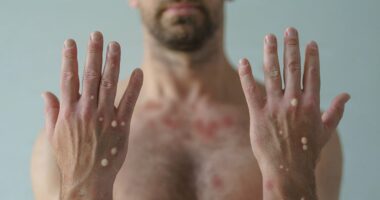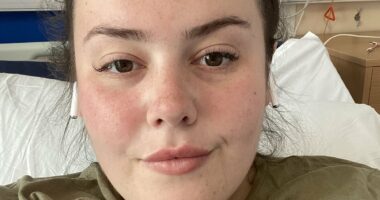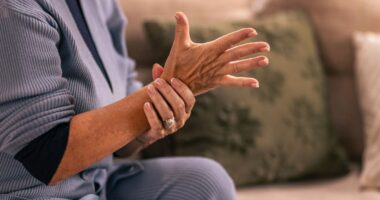Share this @internewscast.com
Kayemille Goss was relaxing on her back porch in Mexico when she received a call that shattered her world: her youngest son had passed away.
“I started screaming and collapsed to the ground, wishing I could just disappear,” shared the 58-year-old mother of three, struggling to put her devastation into words.
Her son Kaden, a 22-year-old business student, had been staying at a friend’s place near their family residence in Fort Worth, Texas. He had recently returned home for the summer from the University of Oklahoma.
During his stay, Kaden took a widely-used supplement known as kratom, marketed as a stress reliever that costs just $1 per pill, promising to naturally boost energy and calm nerves.
However, this supplement is derived from the leaves of a Southeast Asian plant and contains compounds similar to opioids, which can be 10 to 13 times more potent than heroin.
Despite being associated with numerous deaths across the United States, kratom remains unregulated and easily accessible, with an estimated 1.7 million Americans using it annually.

Kaden Goss, 22, died after taking the supplement kratom with friends. He is pictured above with his mother, Kayemille, and father, Joey. The family are from Fort Worth, Texas
Kayemille said her son had first tried the supplement at a party with friends that summer. After suffering no ill effects, he then purchased it again three days later.
‘They went to have burgers and beers and then stopped off at a vape shop and picked up some of this kratom they had had at the weekend.
‘There was a plethora of different kinds of kratom at the vape shop, and I don’t know the exact brand they purchased, but I know it was in tablet form and it contained 7-hydroxymitragynine [7-OH, and the naturally-occurring substance in kratom],’ Kayemille said.
Later that evening, while at a student’s university campus house, Kaden fell asleep on the couch and did not wake up the next day.
It is not clear how many kratom tablets he took but his friends said he had not shown any unusual symptoms after taking the supplement.
A toxicology report by the medical examiner in Tarrant County, which covers Fort Worth, found that Kaden had elevated levels of mitragynine and 7-OH – opioid-like substances in his system, which are found in the supplement.
These depress the central nervous system, producing the relaxed feeling that kratom is known for. But in high doses, they can also suppress the nerves that control breathing, slowing it and reducing oxygen levels in the body, which can be fatal.

Kratom is a supplement made from the leaves of a plant in Southeast Asia. It is sold as a natural way to boost energy and ease nerves but also contains opioid-like compounds that are ten to 13 times more powerful than heroin
In previous cases, deaths linked to the supplement have been attributed to ‘acute mitragynine intoxication’, or an overdose of kratom that caused respiratory failure, a life-threatening condition where the lungs are unable to obtain sufficient oxygen.
The toxicology report also found that there was alcohol in Kaden’s body and low levels of clonazepam, a common anti-anxiety medication taken by 2.2million people in the US every year.
Clonazepam and kratom both have a depressive effect on the nervous system and, when taken together, they may raise the risk of respiratory problems, according to doctors.
The American Addiction Centers warns online that kratom should not be taken in combination with other substances, saying this raises the risk of users suffering from dangerous side effects.
A report from the Tarrant County medical examiner’s office notes that Kaden’s death was caused by mitragynine, 7-OH, clonazepam and ethanol toxicity.
Kayemille told the Daily Mail she was now speaking out to alert other parents and young adults to the dangers of kratom.
She said: ‘I’m a very proud American, but it’s so disheartening that this is going on in our country where we’re meant to be protected.
‘As a mother, it terrifies me and angers me that this is allowed to stay on the shelves. It needs to be considered a controlled substance and against the law.’

A toxicology report by the medical examiner in Tarrant County found that Kaden had elevated levels of mitragynine and 7-OH – opioid-like substances in his system, which are found in the supplement kratom
Kayemille said: ‘He was our youngest. He was the smartest in our family and was very gifted and on the honor roll.
‘If we could save just one family from having to go through the agony we have gone through, that is what Kaden would want.
‘We have to follow through with this. His life had so much meaning and we want his death to have just as much meaning as his life.’
Kratom has already been linked to a series of deaths in the US, including that of 23-year-old Ethan Pope, who died in his apartment with his puppy at his side, and 27-year-old Robert ‘Wyatt’ Wheeler.
But the supplement remains legal to use in the US at a federal level.
The Drug Enforcement Administration (DEA) proposed making kratom a Schedule I substance in 2016, which would have put the supplement into the most restricted drug category in the US alongside heroin, LSD and ecstasy.
But it withdrew the proposal a few months later amid public outcry after receiving a letter signed by more than 50 members of Congress opposed to the measure.

The Goss family is now raising awareness about their son to warn others of the dangers posed by the kraton
The FDA has also repeatedly warned about the risks of taking kratom, saying that the supplement is not approved for any use by the agency and that too few studies have been carried out to confirm its safety.
Currently, seven US states, Alabama, Arkansas, Indiana, Louisiana, Rhode Island, Vermont and Wisconsin, have banned the possession, distribution and sale of kratom.
All of these states, except Vermont, have also listed kratom a Schedule I controlled substance.
In its notice proposing listing kratom as a Schedule I substance in 2016, the DEA said: ‘Kratom is abused for its ability to produce opioid-like effects and is often marketed as a legal alternative to controlled substances.
‘Kratom has a high potential for abuse, has no currently accepted medical use in treatment in the US, and has a lack of accepted safety for use under medical supervision.’
Following his death, Kaden’s family held a funeral on June 12 where 800 people attended in person and 11,000 more watched online.
Fort Worth Police Department confirmed they attended Kaden’s friend’s address on June 5 this year. They said he was pronounced dead on scene.
